How to Form the Past Continuous Tense
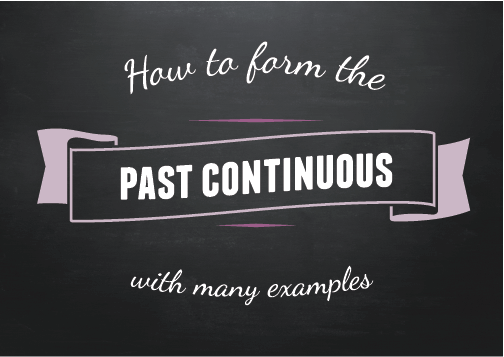
In this section, we'll look at how to form the past continuous in the affirmative, negative and question forms. I've included many examples to help make everything very clear. Before we get started, you may also hear this tense called the past progressive tense.
[Note: Click here to learn how to use this tense.]
Past continuous positive form
To form the past continuous, we use the was / were form of the verb "to be" plus the infinitive of the verb plus an -ing ending.
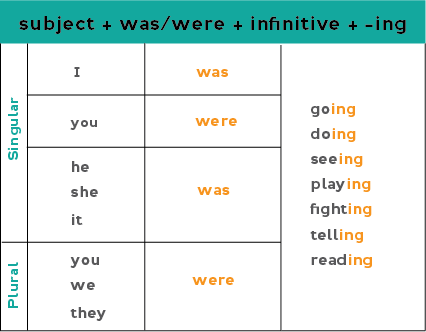
Examples:
- She was going to school.
- You were all doing the chores together.
- He was seeing a new girl last month.
- Sadly, she was playing games with me.
- We were fighting about politics all evening long.
- You were telling me funny jokes.
- They were reading bedtime stories for hours last night.
Past continuous negative form
To make an affirmative (positive) statement negative, add "not" before the verb + -ing. You can also use a contraction (wasn't / weren't). We use contractions frequently in spoken English.
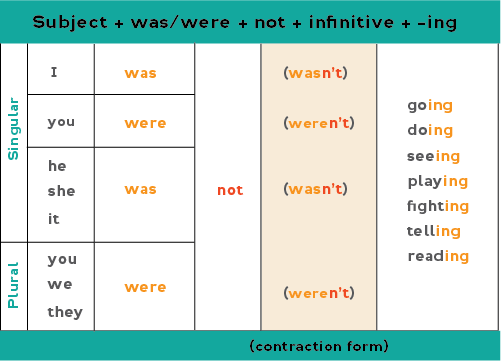
Examples:
- I was not going to bed. / I wasn't going to bed.
- You were not doing your homework.
- The children weren't sleeping during the drive home.
- My boyfriend was not telling me the truth.
- They were not playing this week.
- She wasn't planning her wedding.
- They were not studying English last week during vacation.
Past continuous yes/no questions (positive)
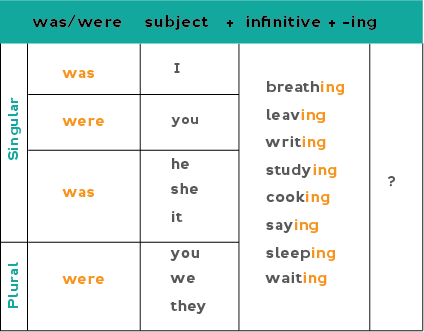
Questions that can be answered with "yes" or "no" answers are formed by inverting the subject and correct form of the verb "be" (was / were). (Inverting means we change the order of the subject and verb form:)
Affirmative statement: I was sleeping. (the subject "I" is first, then the verb form "was")
Affirmative question: Was I sleeping? (to make a question, the verb form "was" comes first then the subject "I").
Examples:
- Was I snoring?
- Was he studying all night again?
- Was the baby crying a lot today?
- Were we talking too loud last night?
- Were we eating lots of candy?
- Were they playing nicely today or were they fighting?
Wh- questions past continuous
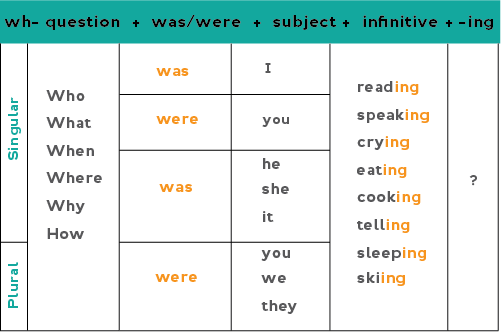
Examples:
- Where was he going?
- Where were they flying to?
- How were your children getting along?
- Why were the buses running late?
- What was your cat eating?
- What was the policeman telling us?
- What instruments were those musicians playing?
- Where were the children hiding?
- How was your new car working?
Spelling changes
Be careful as there are also some spelling changes:
Spelling: Verbs that end with one -e
For verbs that end with one -e, drop the -e and add -ing. Note that these verbs the -e sound at the end is silent. (e.g., believe, bake, take, love).
- achieve — achieving
- hate — hating
- live — living
- take — taking
- strike — striking
- bike — biking
- make — making
- have — having
- dance — dancing
But:
With verbs ending with a long -e sound, add -ing as normal:
- see — seeing
- be — being
- flee — fleeing
- agree — agreeing
Spelling: Short one-syllable verbs ending in CVC
If the verb has one syllable and ends with CVC (a consonant + vowel + consonant), we double the final consonant before adding the -ing ending:
- sit — sitting
- get — getting
- pet — petting
- plan — planning
- run — running
- put — putting
- stop — stopping
- trim — trimming
- win — winning
Spelling: verbs ending in w, x and y
Notice these verbs end in CVC (consonant vowel consonant). However, do not double the consonant for verbs that end in w, x or y.
- glow — glowing
- flow — flowing
- show — showing
- stay — staying
- wax — waxing
Spelling: Two or more syllable verbs
When verbs ending in ending in CVC (consonant vowel consonant) have two or more syllables, double the last consonant if the last syllable is stressed.
- begin — beginning (be / GIN = the last syllable is stressed)
- forget — forgetting (for / GET = the last syllable is stressed)
- upset — upsetting
- regret — regretting
- prefer — preferring
- admit — admitting
However, when the last syllable is not stressed, just add -ing as usual.
- benefit — benefiting ( be / NE / fit = second syllable is stressed not the last)
- happen — happening (HAPP / en = first syllable is stressed not the last)
- open — opening
- listen — listening
- shiver — shivering
Spelling: Verbs ending in -ie
If a verb ends in -ie change 'ie' to 'y' then add -ing.
- die — dying
- lie — lying
- tie — tying
Check back for exercises that will help you practice the past continuous tense in its different forms.
Now that you've learned how to form the past continuous, click here to learn how to use it.
- Home Page ›
- Main Grammar Page ›
- Use: Past Continuous >
- Form: Past Continuous
